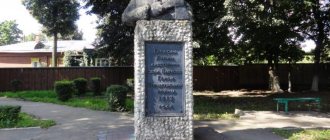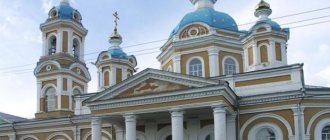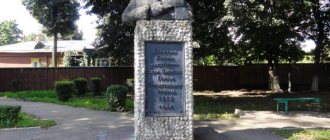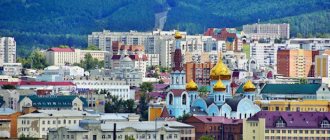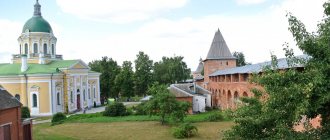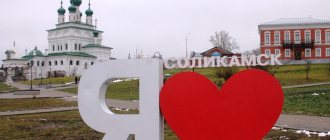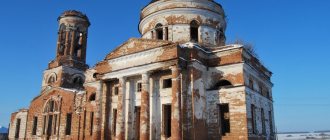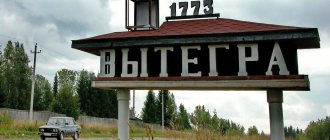The Tula region is a region of Central Russia with an incredibly rich and ancient history. The first human settlements in this region appeared in the Paleolithic era - 12 thousand years ago. From the 7th century AD. Slavic tribes of the Vyatichi settled here, becoming part of Kievan Rus, and later creating their own Belevsky principality. In the late Middle Ages, this part of the Russian Plain was at the center of the upheavals that befell the young Moscow state.
Did you know? The Tula region is the birthplace of many creative personalities, but its most famous son is Lev Nikolaevich Tolstoy.
The best attractions in the Tula region are, of course, gingerbread cookies, samovars and weapons, but besides them there is something to see here! This region is one of the main centers of industry in Russia and a place rich in cultural and historical heritage.
Important! Cheap accommodation for tourists exploring the sights of the Tula region can be rented in the picturesque village of Gora Uslan.
Cities of the Tula region
After the collapse of the USSR, most of the regional centers of the Tula region lost their economic potential, and their residents began to leave en masse for neighboring Moscow. But today this region is actively developing, and in its cities there are many entertainments and attractions available for tourists.
The city of Tula was founded at the end of the 11th century and until the middle of the 17th century was considered the outskirts of the Moscow kingdom. Today it is a large administrative and industrial center and the capital of the region of the same name, with a large number of attractions.
The best places in Tula for travelers are museums dedicated to weapons, gingerbread and samovars, as well as the main pearl of the city - its Kremlin.
Did you know? In 2014, Tula was recognized as the most comfortable city in Russia.
Novomoskovsk, Tula region, is an unusually rich city in attractions that will give you a lot of positive emotions and beautiful photos.
It was founded in 1930, on the site of the village of Bobriki, the former noble estate of the illegitimate descendants of Count Orlov - the Bobrinsky family. Until 1961, this settlement, created for the needs of workers of the new chemical plant, was called Stalinogorsk. The main attractions in Novomoskovsk:
- Source of the Don;
- square of military glory;
- railway for children;
- Assumption Monastery.
Venev . A settlement in the Tula region, which, thanks to its preserved wooden architecture, is included in the list of 115 Russian cities of historical value. It was founded in the 14th century on the banks of the Venyovka River and has preserved a rich historical and cultural heritage. The main attractions of the city of Venev, Tula region, are its iconic architectural structures:
- Epiphany Church,
- St. Nicholas Monastery,
- Resurrection Cathedral,
- Church of the Intercession,
- Bell tower of St. Nicholas Church.
Important! Most of the churches are located in the very center of Venev, on Red Square.
Suvorov . This settlement, named after the great commander, is located in the west of the Tula region. Suvorov is one of the youngest cities in this region, founded in 1954 on the site of a workers’ village at the Cherepetskaya State District Power Plant. The main attractions of the city of Suvorov, Tula region: clay quarries, Church of the Icon of the Mother of God, art museum, Church of the Epiphany.
In addition to the cities listed above, there are many other settlements rich in attractions in the Tula region: Epifan, Belev, Chern, Bogoroditsk, Aleksin, Shchekino, Yasnogorsk.
The best things tourists should see there:
- St. Nicholas Cathedral in the village of Epifan;
- Holy Cross Convent of Belyov;
- Bogoroditsk palace and park ensemble;
- Yasnogorsk House of Culture;
- Egnyshevsky spring in the vicinity of Aleksin;
- Kolosovo estate in Aleksin;
- Chernsky Palace of Culture;
- monument to Tolstoy and Turgenev in the village. Black;
- Yasnaya Polyana estate in Shchekino.
Sights of the Zaoksky district of the Tula region
Zaoksky district is located in the northeastern part of the Tula region. This region, whose settlement began only at the end of the 15th century, is of interest to travelers primarily for its natural resources. In addition to natural monuments, in the Zaoksky district there are several unique cultural and architectural attractions:
- Estate "Dvoryaninovo" . The house of the famous Russian writer and agronomist Andrei Timofeevich Bolotov, who for his services in agriculture was appointed manager of the estates of Empress Catherine II. The estate is located on the banks of the Skniga River, and its territory offers stunning views of the surrounding area. In the summer, in addition to viewing the museum’s exhibitions, tourists will be able to stroll through Russia’s first landscape park, swim in the pond, or look at the garden with medicinal herbs.
- Museum of V. F. Rudnev . Vsevolod Fedorovich Rudnev is a Russian rear admiral, a native of the Tula region. It was he who was the commander of the famous cruiser “Varyag”, whose crew died heroically in the Russian-Japanese War. The Museum named after Rear Admiral Rudnev was opened in 2004 to mark the 100th anniversary of this event. The collection is based on the personal belongings of sailors and officers, as well as photographs and documentary evidence of those events. Of particular interest to visitors are the exhibitions of the Small Hall, which is designed in the style of a wardroom.
- Estate of V. D. Polenov. A museum-reserve in the house of the famous artist Vasily Dmitrievich Polenov, which houses the works of many Russian painters. The estate was built in 1892, on the territory of the village of Bekhovo, according to the design of V.D. Polenov himself. This building was planned to be built in the “Scandinavian” style, but today this type of building is usually called “Polenovsky”.
Estate "Dvoryaninovo"
Other attractions of Zaoksky district:
- Church of the Life-Giving Trinity;
- bust of V. F. Rudnev;
- Kazan Chapel;
- Adventist Theological Seminary.
Cultural attractions of the Tula region
The Tula region has given the world an unusually large number of famous creative personalities, and, of course, this has affected the number of cultural attractions in this region.
- Yasnaya Polyana . One of the main attractions for which tourists come to the Tula region is the Yasnaya Polyana estate. It was here that the great Russian writer Lev Nikolaevich Tolstoy was born, lived and worked. On the territory of the estate there are several interesting architectural monuments: the Volkonsky house, the Kuzminsky outbuilding, ponds and a birch alley. But the main attraction is the Tolstoy house-museum, created in 1921 through the efforts of the writer’s daughter. The collection is based on Lev Nikolaevich’s personal belongings and his manuscripts.
- Veresaev House-Museum . The only museum dedicated to this famous writer and literary critic is located in the estate where he was born and lived from 1867 to 1945. The museum collection is based on the personal belongings of V.V. Veresaev, autographed literary works, and most importantly, rare copies of the book “Notes of a Doctor,” which brought him world fame. Today, the estate often hosts musical evenings and the literary association “Muse” operates. The head of the museum, the famous Tula writer, Victoria Tkach.
- Kulikovo field . The State Museum-Reserve, which was created in 1996 on the site of the Battle of Kulikovo that took place in the 14th century. It includes the Temple of St. Sergius of Radonezh, the obelisk of Dmitry Donskoy, the Church of the Nativity of the Virgin, the estate complex of the merchant A.E. Baibakov. Tourists are offered many exciting excursions and thematic quests. In 2005, the institution received the Changing Museum in a Changing World award in recognition of its technological innovation.
Yasnaya Polyana
Other cultural attractions:
- Tula Helmet Museum (weapon museum);
- Tula Regional Philharmonic;
- Bogoroditsky Palace-Museum;
- museum-reserve named after the artist V. D. Polenov;
- necropolis of the Demidovs;
- regional art museum;
- museum and memorial ensemble of the village of Monastyrshchino.
Natural attractions
The nature of the Tula region is extremely rich and diverse. Most of the region is occupied by the Oka River basin, which, together with its tributaries, provides tourists with recreation areas with clean beaches, as well as hunting and fishing opportunities. Unfortunately, due to unwise logging, very few forests remain in this area; they occupy less than 14% of the total area of this region.
- Horse-Stone . This pile of quartzite-like sandstone is located on the banks of the Krasivaya Mech River, in the vicinity of the village of Kozye. There are many secrets and legends associated with this natural attraction. For example, local residents claim that this stone gives men special strength, and in ancient times cult rituals related to fertility were held here. According to researchers, this monument probably served as an ancient “compass”, and according to another version, it was erected in honor of deliverance from the Mongol yoke.
- Arboretum of Krapivensky forestry enterprise . The dendrological park in the village of Selivanovo is one of the most popular places among guests of the Tula region. The territory of this complex, with a total area of more than 5 hectares, was recognized as a natural monument in 1978, and since the late 1990s. belongs to the special list of botanical gardens of the Russian Federation.
- Volovo Lake . One of the main attractions of the Volovsky district of the Tula region. This lake is located in the basin of the Central Russian Plateau and is a natural reservoir of karst origin.
- White Mountain in Plavsk . This natural monument of regional significance is a geological outcrop of Tula black soil in the bend of the Plava River. This attraction has been known to researchers since the beginning of the 20th century and attracts attention primarily for its flora and fauna, which is atypical for the Tula region.
- Olen River . One of the rivers of the Tula region with a total length of 22 kilometers, flowing into the Shivoron River. It is interesting to tourists primarily as a watering place for deer, as well as for its gently sloping banks, which are convenient for picnics.
Horse-Stone
A few facts about Tula
- The city was founded on the banks of the Upa River, first mentioned in 1146.
- Tula is a large industrial, scientific and cultural center, which in 2014 took 3rd place in the All-Russian competition for “The Most Comfortable Urban Settlement in Russia.”
- The city is famous for its heroic defense during the Great Patriotic War. Finding themselves almost completely surrounded, the defenders of Tula did not surrender the city.
- In 1976, Tula was awarded the title of hero city.
- The population of Tula is about 480 thousand people.
- The distance from Tula to Moscow is 180 km, to Kaluga - 110 km, to Serpukhov - 90 km.
Yasnaya Polyana
Fans of Russian literature are regulars at Yasnaya Polyana. The ancient estate of Lev Nikolaevich Tolstoy is located in the Shchekinsky district, 15 km from Tula and 199 km from Moscow.
Buses, minibuses and taxis go there from the regional center.
View of L.N.'s house Tolstoy at the Yasnaya Polyana estate
Tula province is the writer’s birthplace and the place where he lived for more than 50 years. The memorial museum displays antiques, furnishings, books, manuscripts and photographs of Tolstoy and his family. On the edge of a ravine, in the forest, there is a modest grave of the writer.
Tula State Museum of Weapons
Website: https://www.museum-arms.ru
Appeared back in 1873 at an arms factory. Now it is located in 2 buildings at once:
- old - on the territory of the Tula Kremlin;
- new - on Oktyabrskaya street, 2.
The exhibitions of the old museum make it possible to trace the evolution of weapons making and see with your own eyes artifacts from the 16th to the 21st centuries. Among the exhibits are guns that represented the Russian Federation at the World Exhibition in Paris in 1900, awarded the Great Gold Medal, as well as miniature models of weapons.
In the new museum building, the viewer is offered modern multimedia technologies in the presentation of weapons collections: virtual storytellers, holographic display cases and volumetric-spatial compositions. With the help of innovative technologies that create an “immersive effect”, you can immerse yourself in another era.
Atlas, Cities and countries, seas and oceans. Around the World, Mysteries of the 20th century, The whole world is in your hands
Everyone knows the story about the Tula master Lefty, who shoed a flea. The Tula region has always been famous for the skillful hands of its inhabitants, who knew how to assemble a sweet-sounding accordion, make a steep-sided copper samovar, and serve delicious Tula gingerbread for tea. And it all started with the Demidov blacksmiths and the first factory that made beautiful guns commissioned by the Russian treasury and armed the Russian army with them. And the Tula people themselves had to fight on their own land: both in the Battle of Kulikovo and in the Great Patriotic War.
SLAVA KULIKOVA POLYA
Today, Kulikovo Field, like the Tula Kremlin and Yasnaya Polyana, is one of the main attractions of the Tula region and a memorial site, including archaeological sites, architectural monuments and monumental art.
The relief of the region in the west, north-west and north is strongly dissected, slightly hilly in the central part, a weakly dissected plain stretches in the east, undulating in the south and south-east, with heights of about 300 m, cut by a complex network of deep ravines. Karst landforms are characteristic of local landscapes; sinkholes, hollows, underground voids, caves, grottoes.
The relief combines gently convex, sometimes flat interfluves and wide river valleys.
About 80% of the region's territory belongs to the Oka basin, which flows along the western and northwestern edge of the region with numerous tributaries. In the section from Serpukhov to Stupin, approximately along the Oka River, the border of the Moscow and Tula regions runs. Starting from the city of Aleksin, this river is navigable.
In the east of the region there is the source of the Don (Atlas No. 59), which originates 50 km north of the Kulikovo field (Atlas No. 314) within the city of Novomoskovsk. The most notable tributaries of the Don in the region are the Nepryadva and the Beautiful Mecha.
According to the chronicle documents "Zadonshchina" of the late XIV - early XV centuries. and “The Tale of the Massacre of Mamaev” of the 15th century. It is on the banks of the Nepryadva that the place where the historical Mamaevo, or Don Massacre, today known as the Battle of Kulikovo, took place on September 8, 1380. Confusion in determining the exact location of the battle arises from the version that in the Old Russian language the word “mouth” also meant the source of the river.
There are no large lakes in the region, but there are several reservoirs, the largest is Pronsky, the oldest is Shatsky on the Shat River, formed back in 1932.
In ancient times, Finno-Ugric tribes, partly Baltic, lived on Tula land. From the 8th century Slavic tribes of the Vyatichi lived here, leaving behind numerous mounds and fortifications on the territory of the present Tula region.
The first mentions of the cities of the Vyatichi date back to the 12th century. Tula - an ancient city in the land of the Vyatichi Slavs - was first mentioned in the Nikon Chronicle in 1146. The chronicle reports that the Prince of Chernigov “Svyatoslav Olgovich went to Ryazan, and was in Mchensk, and in Tula, and in Dubka on the Don.” However, there is a high probability that Tula was already in the 9th-11th centuries. was one of the fortified settlements of the Vyatichi.
In 1382, Tula was mentioned in the contractual document between Prince Dmitry Donskoy of Moscow and Prince Oleg Ivanovich of Ryazan.
The Tula land was at one time part of the Chernigov principality, then it was included in the Moscow principality, then in the Ryazan principality.
For several centuries, the Tula land was attacked by Mongol nomads.
The most important historical milestone in the Tula region was the Battle of Kulikovo in 1380. Its outcome largely determined the future fate of the Russian state, becoming the beginning of the liberation of North-Eastern Rus' from the Golden Horde.
The Kulikovo Field memorial complex includes several museums, including the Museum of the Battle of Kulikovo on Red Hill, the Museum and Exhibition Museum, the Historical and Ethnographic Museum, the museum complex in the village of Monastyrshchina, as well as more than 380 archaeological monuments from different eras and ten churches, including An outstanding architectural monument is the Church of Sergius of Radonezh. Here, not far from the battle site, relict areas of steppe vegetation and forests close to virgin ones have been preserved.
The Tula region is located in the north of the Central Russian Upland. In general, the landscape of the region is a gently undulating erosional plain.
REGION-MUSEUM
In terms of the number, variety and size of museums, the Tula region is among the first in Russia - from the vast Kulikovo Field to the estates of great masters of the pen and brush.
Since 1503, the Tula land finally joined Moscow. Bloody battles took place here: the Battle of Belyov in 1437, the heroic defense of Aleksin in 1472, the Battle of Sudbischenskoye in 1555.
In the XVI-XVII centuries. Tula became an important fortified point on the southern outskirts of the Moscow state. In the 16th century A large abatis line passed through these lands: a defensive line that served to protect the southern borders of the Moscow principality from raids by nomads. On the territory of the Tula region, the remains of earthen fortifications of the 16th-17th centuries have been preserved. in the city of Venev, the villages of Zvoika and Krapivna.
In 1514-1520 A stone Kremlin was built in Tula, and from that time on it was already a fortress city, one of the strongest centers of defense of Russian lands. In 1552, the residents of Tula, taking refuge in the Kremlin, withstood the siege of the 30,000-strong army of the Crimean Khan Devlet-Girey. In 1607, in the Tula Kremlin, rebel peasants led by Ivan Bolotnikov defended themselves against the tsar’s army of Vasily Shuisky.
Since the 17th century. The Tula region loses its defensive significance, but the development of local trades and crafts begins.
In 1637, the first ironworks in Russia were built in Tula. In 1696, the Tula blacksmith Nikita Demidov built two blast furnaces and hammer workshops at the mouth of Tulitsa. Blacksmithing began to develop in Tula. But the manufacture of firearms received special development. The products of Tula masters of “fire combat” have been known since the 16th century, and in 1712, by decree of Peter I, a state-owned (state) arms factory was founded in Tula. He became the main supplier of weapons during the Patriotic War of 1812, producing 600 thousand guns for the Russian army.
The Tula governorate with its center in Tula was formed in 1777.
Since the 18th century here the production of samovars, gingerbreads, harmonicas, locks and hardware began to develop, and all of them became symbols of Tula and its craftsmen.
In 1937, during the years of Soviet power, the Tula region took shape within its modern borders.
During the Great Patriotic War, there were battles with German troops in the region; out of 40 districts, 33 were occupied by the enemy, 6 were partially occupied, and only one was not occupied by the enemy. The heroic defense of Tula in October-December 1941 went down in the history of the Great Patriotic War. Tula covered the approaches to Moscow from the south; here the German tank army of General Guderian was stopped, bled dry and destroyed.
The administrative center of the region is Tula, it is a large industrial, scientific and cultural center, as well as an important railway junction. The city has several hundred historical and cultural monuments.
Another old city in the Tula region is Aleksin, founded at the end of the 13th century. as a fortress at the turn of the Tarusa principality and transferred to Moscow in the first quarter of the 15th century. In the 19th century The city gained fame thanks to the figure casting plant, where the fence and gates of the Alexander Garden of the Moscow Kremlin were made.
The history of the Tula region is connected with the name of Leo Tolstoy: next to Tula there is the museum-estate “Yasnaya Polyana” (“Atlas” No. 384), where he was born and lived for about 60 years; created the novels “War and Peace”, “Anna Karenina”, many novellas and short stories. The writer's grave is also located here. The Polenovo Estate Museum was created on the basis of the Borok estate of the artist Vasily Polenov; it houses a collection of paintings by Russian painters.
FUN FACTS
■ Within the Tula region, half of all the deposits of the Moscow Region brown coal basin are concentrated, which played a crucial role in the development of the local energy sector. But after power plants switched to natural gas and fuel oil, production began to decline, and to date, almost all mining enterprises have been closed. The last operating mine in the basin, Podmoskovnaya, was located in the Tula region and was flooded in 2010
■ The 82-meter bell tower of the All Saints Cathedral is the tallest building in Tula and the Tula region, it is one meter higher than the belfry of Ivan the Great in Moscow.
■ Gremyachevsky karst caves near the village of Gremyacheye are also known as the Arapovsky Cave Monastery. In 1849, these caves began to be dug by the peasants of this village, carried away by the idea of a certain devout peasant Yakov Pavlov to create a monastery similar to the Kiev Pechersk Lavra. Gradually, more people began to come to worship in the caves than to all the churches of the Gremyachevsky parish. Church revenues were falling, and by order of the governor and the insistence of the consistory, an investigation was launched. The idea of building an underground monastery was declared “sectarian”; further “digging” of caves and people going to them were prohibited.
■ At the beginning of the 18th century. Tsar Peter I, for military and trade purposes, decided to connect the Oka with the Don through the Shat River and Ivan Lake. For this purpose, they began to dig the Ivanovo Canal, which was supposed to pass through the territory of the present Tula region. This was one of the first attempts to build a navigable hydraulic structure in Russia, as a result of which the Ivanovo water system was to appear. For construction, 35 thousand serfs were gathered, which the boyars, fearing the tsar’s wrath, were forced to “share”. British engineers supervised the construction of the canal. The first ships passed through the Ivanovo Canal in 1707. It turned out that navigation was only possible during the spring flood period. Therefore, in 1720 all work on the canal was stopped. Currently, the canal is almost completely destroyed, but its remains are being studied by expeditions of historians and local historians.
■ Local legends connect the origin of the name of the river Beautiful Sword with the events of the Battle of Kulikovo: supposedly Mamai, while crossing the river, dropped a particularly valuable sword into its waters. However, most likely, this name is of Finno-Ugric origin: in Udmurt, “sword” means a steep or steep bank.
■ Guryev quarries are located on the banks of the Osetr River, where mining was carried out back in the 14th-15th centuries. Currently, three complexes of underground corridors with a total length of about 120 km have been explored. It is documented that the stone was mined by convicts. Since the stone was of low quality, development stopped a hundred years later when a better stone was found nearby. Today's inhabitants of the caves are foxes and bats. The caves are popular with amateur speleologists, but descending into the quarries is fraught with danger to life.
ATTRACTIONS
■ Natural: the source of the Don River (Novomoskovsk), Krapivensky Arboretum, Gremyachevsky (Arapovsky) karst caves. ■ Historical: Snykhovsky boulder (petroglyphs of the 3rd thousand BC), history, the village of Dedilovo (Vyatichi city of Dedislavl, 12th century), ancient Russian ruins. cities (village of Gorodishchi, XII-XIV centuries), Pokrovsky Dobry monastery (village of Dobroye, 1385 and 1402), Guryev quarries (from the 14th century), Spaso-Preobrazhensky monastery (town of Belev, 1525) , remains of earthen fortifications. (city of Venev, village of Zvoika and Krapivna, XVI-XVII centuries), Krestovoz-Vizhensky monastery (city of Belev, 1625), c. St. Nicholas the Wonderworker (Kochaki village, 1690), Berov House estate (Petrovskoye village, early 1770s), Epifansky locks (early 18th century), Bobrinsky Counts Palace (Bogoroditsk, 18th century. ), estate of the Bobrinsky counts Bobriki (Donskoy, 18th century), memorial. set “Kulikovo Field” (monument-column to Dmitry Donskoy 1848-1850, church-mountain of the Nativity of the Blessed Virgin Mary 1865-1884, church-monument in the name of St. Sergius of Radonezh 1913-1918, monument to Prince Dmitry Donskoy 1980, Music of the Battle of Kulikovo). ■ Cultural: musical estates of agronomist Andrei Bolotov (village of Dvoryaninovo, XVIII-XIX centuries) and writer Leo Tolstoy “Yasnaya Polyana” (building of the 18th-early 19th centuries), Music. merchant life (village Epifan), music reserves of the writer Ivan Turgenev “Bezhin Meadow” (village Turgenevo) and artist Vasily Polenov (Polenovo), doctor of music. writer Ivan Bunin (Efremov). ■ G. Aleksin: Old Assumption Collection. (1688), Nikolskaya c. (1787-1789), New Assumption Sob. (1807-1813), village of the Maslov merchants (late 18th - early 19th centuries).
■ Tula: Tula Kremlin (16th century), C. Flora and Lavra (1796), Lomov Gate (mid-18th century), All Saints Cathedral and Bell Tower (1776-1825, 1863), Kraft village (late 18th century). XVIII - early XIX century), Belolipetskikh village (1872), New trade. ranks and women's gymnasium (1895-1897), Holy Dormition Department, personal. (1898), archive. St. Seraphim of Sarov (1905-1906), Perovskaya gymnasium (1907), d. named after Emperor Alexander II (Museum of Tula Samovars, building 1910-1912), d. Konopatskikh (beginning of the 20th century), Music. “Necropolis of the Demidovs” (1996), music. weapons and “Tula gingerbread”, Batashevsky and Kremlin gardens, Platonovsky park, village of music. writer Vikenty Veresaev.
NUMBERS
Area: 25,679 km2. Population: 1,499,417 people (2017). Population density: 58.4 people/km2. Urban population: 74.76% (2017). Highest point: 293 m, village. Raevo. Minimum height above sea level. m.: 108 m, r. Oka (city from the Moscow region). Distance (Tula): 174 km south of Moscow (as the crow flies). Oka River: length within the region is 220 km.
GENERAL INFORMATION
Location: center of the European part of the Russian Federation. Hell min. affiliation: Central Federal District. Hell min. division: 23 districts, 2 cities of regional subordination. Hell min. center: Tula - 485,221 people. (2017). Cities: Novomoskovsk - 126,479 people, Donskoy - 64,201 people, Aleksin - 58,759 people, Shchekino - 57,973 people, Uzlovaya - 52,377 people, Efremov - 36,181 people, Bogoroditsk - 31,379 people . (2017). Founded: 1937 Language: Russian. Ethnic composition: Russians - 95.3%, Ukrainians - 1.0%, Armenians - 0.6%, Tatars - 0.5%, Belarusians - 0.4%, Azerbaijanis - 0.4%, others - 1.8 % (2010). Religions: Orthodoxy, Islam. Currency: Russian ruble. Rivers: Oka with the tributaries Upa, Osetra, Ista, Perepet and Zusha, Don with the tributaries Ne-pryadva and Krasivaya Mecha. Airport: Sheremetyevo-Moscow (international). Neighboring areas: in the north and north-east. - Moskovskaya, on the east - Ryazanskaya, on the south-east. and S. - Lipetskaya, on the S. and S.-W. — Orlovskaya, on 3. and N.-W. - Kaluzhskaya.
Atlas. The whole world is in your hands #395
Read in this issue:
SOLOVETSKY MONASTERY: Monastery on the boulders CHAPULTEPEC AND PASEO DE LA REFORM: Park and main avenue of the PROVINCE OF THE NORTHWEST: Roof of Indochina HARLEM: Capital of North Holland TOMBUCTU: Three mosques on the edge of the earth TULA REGION: Land of masters
Like
SocButtons v1.5
Memorial complex to the Defenders of the Fatherland's sky
The huge monument, located at the entrance to the city, appeared in 2013. It is dedicated to the pilots of the 141st Red Banner Fighter Regiment of Tula.
The dimensions of the complex are almost 100 meters in diameter and about 30 meters in height. In the center of the monument are German and Soviet aircraft, the scale of which is 1 to 1. Both aerial devices stand on shaped stands that resemble flight trajectories. At the same time, the enemy pilot falls to the ground, and the Soviet pilot rises into the sky. The Eternal Flame is lit in the central part of the memorial complex. The creation of the monument was initiated by public organizations, and about 300 million rubles were spent on its construction.
Tula Kremlin
Address: TulaKremlin.rf
Its history begins in 1507, when Vasily III decided to build an oak fortress (fortress) here. In 1509, construction was completed. In 1520 (21) a “stone city” appeared in a wooden fortress. The Kremlin has seen many events over the years of its existence. For example, in 1605, False Dmitry I found refuge here, and in 1607, Ivan Bolotnikov.
In 1930, dilapidated buildings in the Kremlin were demolished. Since the 1960s, comprehensive restoration work has been carried out in the ancient fortress to restore its original appearance. Since 2016, large-scale preparations have been underway for the celebration of the 500th anniversary of the Tula Kremlin, which is scheduled for 2022.
Exhibition Center
In 2022, one of the Kremlin premises was equipped into an “Exhibition Center”; at the moment it includes 4 museums:
- military history;
- folk art;
- samovars and Tula gingerbread;
- history of the Tula Kremlin.
In addition to this, the exhibition hall hosts exhibitions, forums, conferences and business meetings.
The most interesting cities
Most travelers come to see the regional center. Tula
famous for its traditions of arms production, sweet gingerbread and samovars.
The Tula Kremlin
, ancient temples and architectural monuments of the 18th-19th centuries have been preserved in the ancient city
Mother of God Shcheglovsky Monastery in Tula
In addition to Tula, Aleksin is considered an interesting place for excursion tourism. One of the ancient Russian cities was founded in 1326. Travelers are attracted by the Old Assumption and New Assumption Cathedrals, St. Nicholas Church, wooden sculptures of fairy-tale characters in Zhalka Park and the local history museum, which operates in the house of the Maslov merchants.
It is interesting to visit Belyov, a small town on the left bank of the Oka, which traces its history back to 1147. Ancient monasteries and a historical center with buildings from the 18th-19th centuries have been preserved here. For its beauty and monuments, Belev is included in the list of 115 historical cities in Russia.
Holy Dormition temple complex in Aleksin
Bogoroditsk, founded in 1663, is called Tula Peterhof. In a small town there is a palace and park complex built by order of Catherine II for the empress’s illegitimate son, Count Alexei Bobrinsky.
In addition to the palace, there is a green park in Belevo, which is very pleasant to walk in.
Armored train No. 13 Tula worker
At 4 Puteyskaya Street, there is a reminder of the heroic defense of the city during the Second World War. In 1941, when Nazi troops were advancing on Moscow, Tula railway workers created a unique armored train.
Now it has recreated the atmosphere of war times, in which machine guns, racks with live ammunition, and a cannon are installed. At the base of the division there is a club car, a bakery car and a headquarters car. With the help of the exhibits you can understand what the life of soldiers was like during the Great Patriotic War.
Kulikovo field
Obelisk to Dmitry Donskoy on the Red Hill of Kulikovo Field, Tula region. Photo: Natalya Ilyukhina / photobank “Lori”
On the territory of the Tula region, on the banks of the Don River, there is the Kulikovo Field - the place where on September 8, 1380, a battle took place between the Moscow prince Dmitry I Ivanovich and the Golden Horde commander Mamai. For his victory in the Battle of Kulikovo, Dmitry I received the nickname Donskoy.
It was decided to create a museum on Kulikovo Field only in the 19th century. It was proposed by historian and amateur archaeologist Stepan Nechaev to open it. In his Polibino estate in the Ryazan province (now Lipetsk region), Nechaev opened the first museum of the Battle of Kulikovo. In it he placed sabers, chain mail, spear and arrowheads and other archaeological finds.
In 1850, an obelisk was installed on the Red Hill of Kulikovo Field - a black cast-iron column with a golden dome and a cross. The project was prepared by the artist and architect Alexander Bryullov. And at the beginning of the 20th century, the Temple of Sergius of Radonezh was erected here. According to legend, it was this saint who blessed Dmitry Donskoy for the battle. The design of the temple was created by Moscow architect Alexei Shchusev. The building is reminiscent of Russian pre-Petrine churches, and one of the domes repeats the shape of military helmets of the 14th century.
During the Great Patriotic War, the obelisk was destroyed, and the icons and iconostasis were removed from the temple. Restoration of the complex began in the 1960s, and in 1996 a museum-reserve was created here. Its exposition is located not only in the complex on the Kulikovo Field itself, but also in other branches - in the village of Monastyrshchino, the village of Epifan. Permanent exhibitions are dedicated to the history of the Kulikovo Field, as well as the Battle of Borodino, Prokhorovsky and other major battles in Russian history.
Holy Assumption Cathedral
The exact date of construction of the church is unknown, but it is listed in the “Extracts from the built Tula books” (1649). Initially, in the first years of its existence, the church of the Assumption Convent stood on this site. It was rebuilt due to dilapidation and renamed more than once. In 1898, the church was completely dismantled, down to its very foundations, and a completely new two-story building was erected in its place, which was consecrated in 1902. It is made in neo-Russian style from dark red brick with matte black domes and massive crosses. The church is popularly nicknamed “black” for the color of its domes.
After the revolution, the church was closed, and the State Archive of the Tula Region was located in the temple building. During this time, all the walls of the fence and the bell tower collapsed, but inside the church the paintings of the 20th century by artists who studied with Nesterov and Vasnetsov were well preserved.
In 2006, the partially restored premises were returned to the Tula diocese, and services began. In 2012, the cathedral was fully opened, including for believers.
Tula embankment
The city of Tula stands on the Upa River, and the pedestrian “Kazanskaya” embankment runs along it. It got its name from the Church of the Kazan Mother of God, which is located nearby. Improvement of the embankment began only in 2022, when the city bought the area near the river. In 2022, on the occasion of City Day, its opening took place.
Now it is a quiet place for walks and relaxation: with gazebos and benches, playgrounds for children, grounds for table tennis, basketball, hockey and football, as well as bicycle paths. There are viewing platforms and performance areas. A project is being developed to plant a lilac garden, launch rental of bicycles, boats, an open-air cinema, and in winter - the construction of slides and an ice skating rink in the riverbed.
Singing fountain
There are several singing fountains in the city, but the largest of them is located on Lenin Street, near the Gostiny Dvor shopping center. During the summer, he performs every day from 12:00 to 23:00. He doesn't play only on rainy days.
While the fountain is running, various melodies are heard, including Vivaldi's "The Four Seasons" and Freddie Mercury's "The Show Must Go On." The spectacle is accompanied by colorful lighting.
The historical center of Tula
On April 15, 2016, a model of the historical center of Tula was opened at the intersection of Krasnoarmeysky Prospekt and Sovetskaya Street. The composition was cast by sculptor M. Logunova with the support of local historian N. Kirilenko. Postcards and photographs from 1908 and 1913 were used as a sample when creating the layout. The sculpture is cast from bronze, its size is 2.6 by 3.15 meters, and it weighs about 1 ton.
Tula residents liked the new art object, but more than once local historians and history buffs have criticized the model for historical inaccuracies and errors in depicting the real historical center of the city of Tula.
The famous Tula blacksmith Lefty
Everyone knows about the talented Tula master who managed to shoe an English flea in N. Leskov’s book “Lefty”. Despite the fact that the main character of the work is a fictional character, he is very much loved here. This fact is confirmed not only by the sights of Tula erected in his honor, but also by the names of enterprises and products manufactured in Tula.
Monument to Lefty
In 1989, in connection with the celebration of the 50th anniversary of the Tula Machine-Building Plant, a monument to Lefty was made at the enterprise - a symbol of the working skills of the Tula people. The bronze monument depicts a contented Lefty in work clothes and with a bandage on his head. He slightly narrowed his eye and holds in his right hand a flea that he literally just shod. In his other hand he held the blacksmith's hammer tightly.
For a long time, the monument was located on the territory of the plant, but in 2009 it was donated to the city so that all residents and guests of Tula could admire the fabulous craftsman. The monument was erected on Sovetskaya Street, 2, in the historical part of the city.
Sculpture “Lefty Shoes a Flea”
On the 135th anniversary of the publication of “Lefty,” May 27, 2016, an unusual art object called “Taming the Flea” was opened in the city. The sculptor Yu. Shurupov created a huge flea that hangs over Lefty and extends his paw to him, and the master shoes it from the bottom up.
History of the region
In the 4th century AD e. The territory of the modern Tula region was inhabited by the Balts, and four centuries later they were replaced by the Vyatichi. In 1382, the region was annexed to the Moscow Principality. For some time, different princes fought for the cities of Dedoslavl, Belev, Novosil, Aleksin and Venev. As a result of civil strife in 1432, all Tula settlements came under the rule of the rulers of Ryazan.
View of the Tula Kremlin
Several centuries ago, the region was located on the southern outskirts of Moscow, so it performed defensive functions. Residents of the Tula lands have long defended the capital from attacks by the Golden Horde and Crimean Tatars.
In 1929, in connection with state reform, the Tula province received the status of a district, and 8 years later it was transformed into a region. Since then, its borders have remained virtually unchanged.
View of the buildings of the Spaso-Preobrazhensky Monastery in Belev
From the center of Moscow to the center of Tula is 185 km. It is only natural that the Tula region is experiencing a large merger of a wealthy metropolis. Today it is the most economically developed region of our country. Almost 1.5 million people live here. Local residents work in enterprises, in agriculture and forestry, in transport, in construction and willingly receive tourists.
Original monuments of Tula
The sights of Tula are fun, varied and authentic. Many of them have no analogues throughout the world. These include numerous monuments located throughout the city.
Monument to Tula gingerbread
On Lenin Square in Tula there is a huge bronze gingerbread with a diameter of 2.5 m and a weight of 1.3 thousand kilograms. It was solemnly erected and opened on Lefty Day, July 6, 2014. It has the inscription: “For good luck. Tula gingerbread has been known since 1685.” This date did not arise by chance; Tula gingerbread first appears in a scribe book dated 1685.
Sculpture “Tula Tea Party”
In 2014, another sweet discovery of a Tula landmark took place. The sculpture “Tula Tea Party” appeared in the park of the Zarechensky district. The monument is made of bronze and represents a scene of a tea party between a woman and a man holding an accordion in his hands.
Both figures are sitting at a table on which there is a samovar and a printed gingerbread. Animals sat comfortably near the table: a dog and a cat. An unoccupied chair is pulled up to the table so that anyone can join them and take part in the tea party. The author of the project is M. Logunova, who created the sculptural composition for about 4 months.
Tula Dinosaur, or “Monument to Mother-in-Law”
Not far from the exoterrarium, on Oktyabrskaya Street, 26, there is an unusual monument - the Tula Dinosaur. It was opened in 1989, all proportions of the sculpture were clearly verified and observed. According to scientists, this is exactly what the reptile looked like, only the metal copy was slightly reduced in size.
Tula dinosaur dressed as a first-grader
However, local residents did not call the monument a dinosaur for long; at someone’s suggestion, another name took root among the people - “Mother-in-law tomorrow”, “Monument to mother-in-law” or simply “Mother-in-law”. Local tradition tells every new husband to bring flowers to the monument to appease his mother-in-law, and the general hobby of the city is to dress the monument in different outfits on holidays: on September 1 - as a schoolgirl, on New Year - as the Snow Maiden, on Valentine's Day - as a girl of easy virtue , and on International Women's Day - just a woman in a skirt and jewelry.
"Hedgehog in a mushroom meadow"
In September 2015, a cute art object appeared in the park near the Tula Kremlin. The opening ceremony was attended not only by adults, but also by children, who were given the right to “rip the cover off” from the sculptural composition. The surprise was a success, as the kids were delighted.
The composition of the monument looks nice: on the edge there is a bronze figure of a hedgehog the size of a 5-year-old child, frozen in admiration, opposite it is a whole clearing of mushrooms. These include chanterelles, russula, white and even fly agaric.
Over time, local residents and tourists even developed a tradition: when you come to the sculpture, be sure to stroke the hedgehog’s nose for good luck.
Sights of Tula
Day after day, your years fly by in work and worries. From Monday to Friday you spin like a cog or even a gear, and only in the evening at the end of the week do you ask the question: “What should I do on the weekend?”
In the clubs and bars of your city, the process of relaxation already reminds you of the endless “Groundhog Day”. The pigeons in your favorite park are already fed, and the paths are well-trodden. I no longer have the energy to dig around my summer cottage. Even barbecue has already turned into a curse...
You want new experiences... Something that you can post on Instagram, show to your friends, something you can remember and tell your children about, go to places where rarely anyone has been, and when you return you become a different person!
Then get acquainted! Sights of Tula and the Tula region! A colossal number of museums (more only in Moscow and St. Petersburg), unique natural areas, monuments and creative art objects, ancient temples and monasteries, estates of the greatest luminaries of the Russian Empire!
Yes, we are not a city of the Golden Ring. We don't have hills or a Cote d'Azur. But we are original! We are the land of craftsmen! Hero city, southern outpost, shield and arsenal of Russia! Now our secrets are open to you!
All Tula sights preserve the glory and history of people who, from 1146 to our time, touched everything ordinary and mediocre, turning it into a work of art. And it’s not even about gingerbread, samovars or weapons! You can come here, as if to a life-giving source, for inspiration!
A photo taken as a keepsake in any historical place in Tula will awaken pleasant memories. You will involuntarily smile as you scroll through interesting pictures of your trip to the City of Masters in your memory!
Sights of Tula and the Tula region await you in order to point out the cultural values of Russia and the Russian people. From the runes and temple rings of the great Vyatichi to high-precision weapon complexes, from the Oka to the Don, from the walls of the Tula Kremlin to the extreme southern fortresses of the Bolshaya Zasechnaya Line... You will have something to see!
Many attractions have souvenir shops or cafes where you can buy a lot of wonderful things as souvenirs or try local dishes (not just gingerbread, imagine)! Two federal highways M-4 “Don” and M-2 “Crimea” and a railway to the south pass through the region. You can easily reach us in any available way!
This page presents both the sights of the city of Tula and the sights of the Tula region. Object cards store galleries of photos of special places, their descriptions, and addresses of the best objects. Here you can clearly understand where to go for the weekend.
The card index of your holiday, collected in one place, was created specifically so that the sights of the city of Tula from a dark forest turn into a clear and convenient route for you while visiting our region!
Turn descriptions, addresses and ticket prices into pleasant memories!
Plan! Come! Be impressed!
